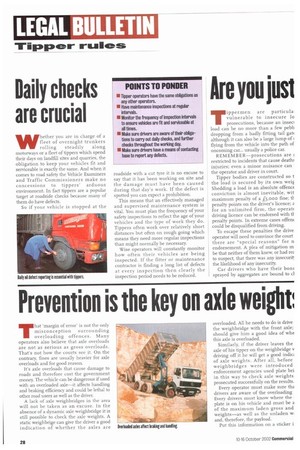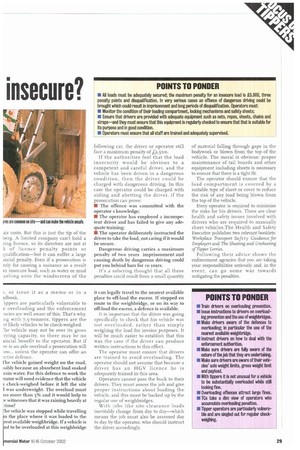Are you just insecure?
Page 28

Page 29

If you've noticed an error in this article please click here to report it so we can fix it.
Tippermen are particula vulnerable to insecure lo prosecutions, because an inseci
load can be no more than a few pebb dropping from a badly fitting tail gati although it can also be a large lump of flying from the vehicle into the path of oncoming car... usually a police car.
REMEMBER—prosecutions are I restricted to incidents that cause cleath.1 injuries; even a minor nuisance can the operator and driver in court.
Tipper bodies are constructed so t the load is secured by its own wei{ Shedding a load is an absolute offenct conviction is almost inevitable, wit maximum penalty of a f5,00o fine; tlpenalty points on the driver's licence; a for an unlimited firm, the operatt driving licence can be endorsed with ti penalty points. In extreme cases offent could be disqualified from driving.
To escape these penalties the drive operator will need to convince the court there are "special reasons" for n endorsement. A plea of mitigation m be that neither of them knew, or had rea to suspect, that there was any insecurit the likelihood of any insecurity.
Car drivers who have their bon/ sprayed by aggregates are bound to cl
air costs. But this is just the tip of the berg. A limited company can't hold a eing licence, so its directors are not at k of licence penalty points or qualification—but it can suffer a large incial penalty. Even if a prosecution is rely for causing a nuisance as a result in insecure load, such as water or mud ashing onto the windscreen of the following car, the driver or operator still Face a maximum penalty of L2,500.
If the authorities feel that the load insecurity would be obvious to a competent and careful driver, and the vehicle has been driven in a dangerous condition, then the driver could be charged with dangerous driving. In this case the operator could be charged with aiding and abetting the driver, if the prosecution can prove: • The offence was committed with the operator s knowledge; • The operator has employed a incompetent driver and has failed to give any adequate training;
• The operator deliberately instructed the driver to take the load, not caring jilt would be secure.
Dangerous driving carries a maximum penalty of two years imprisonment and causing death by dangerous driving could put you behind bars for To years.
It's a sobering thought that all these penalties could result from a small quantity of material falling through gaps in the bodywork or blown from the top of the vehicle. The moral is obvious: proper maintenance of tail boards and other equipment including sheets is necessary to ensure that there is a tight Et The operator should ensure that the load compartment is covered by a suitable type of sheet or cover to reduce the risk of any load being blown from the top of the vehicle.
Every operator is required to minimise the risks for his drivers. There are clear health and safety issues involved with drivers who are required to manually sheet vehicles.The Health and Safety Executive publishes two relevant booklets: Workplace Transport Safety Guidance Jr Employers and The Sheeting and Urisheeting of Tipper Lorries.
Following their advice shows the enforcement agencies that you are taking your responsibilities seriously and, in the event, can go some way towards mitigating the penalties.




































































































































































